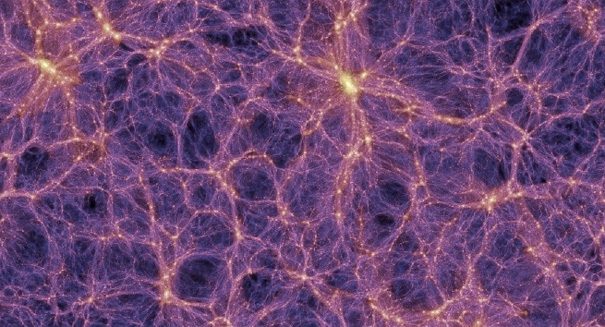
Scientists glimpse dark matter for the first time.
How do you see something that to the naked eye appears invisible? You use science. Scientists have discovered a faraway quasar that lit up a huge nebula comprised of diffuse gas. This became the first time scientists were able to see for the first time the complex network of dark matter strands that connect the galaxies together.
The scientific team from the University of California in Santa Cruz, who is responsible for this discovery, found the huge gas nebula by using the 30-foot Keck I telescope in Hawaii. This nebula extends around 2 million light-years across intergalactic space.
“This is a very exceptional object: it’s huge, at least twice as large as any nebula detected before, and it extends well beyond the galactic environment of the quasar,” said Sebastiano Cantalupo, first author of the paper, which was published in the scientific journal Nature.
Researchers have long known something was holding up the universe, even if they couldn’t see it. According to the researchers in the study, dark matter makes up about 84 percent of the material forming the cosmological web.
Scientists have been able to confirm this web through computer simulations showing the evolution of the universe’s structure. These simulations show how dark matter is distributed on a large scale, and it also shows where galaxies form and how the black matter filaments connect them.
Through gravitational pull, ordinary matter—the matter we can see—follows the distribution of dark matter. According to this principle, filaments of diffuse, ionised gas are expected to trace a similar pattern to what scientists have been seeing in simulations of dark matter.
During their study, the researchers noticed the fluorescent glow of hydrogen gas, which was a result from exposure to the intense radiation from the quasar.
“This quasar is illuminating diffuse gas on scales well beyond any we’ve seen before, giving us the first picture of extended gas between galaxies,” said J Xavier Prochaska, coauthor of the research.
The distance to the quasar is roughly 10 billion light-years. This distance was far enough that the light became “stretched” by the expanding universe, going from an invisible ultraviolet wavelength to a visible violet color by the time it reached the Keck telescope. It also hit the Low Resolution Imaging Spectrometer (LRIS), which was also used for the study.
The researchers stated that these filaments have never been seen, until now. “It provides a terrific insight into the overall structure of our universe,” said Prochaska.
is a